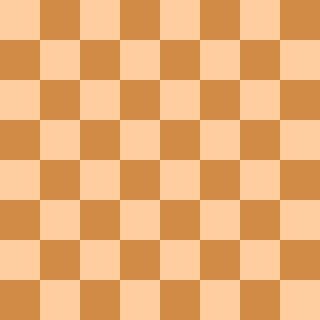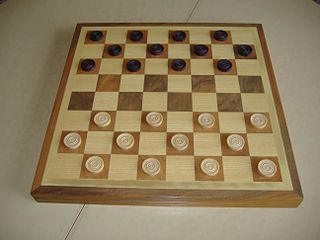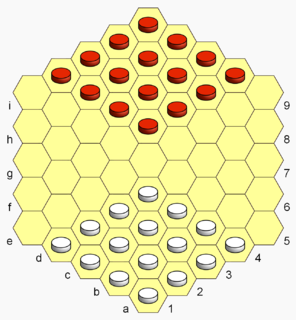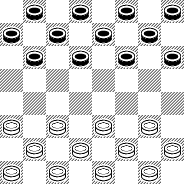
Sternhalma, commonly known as Chinese checkers or Chinese chequers, is a strategy board game of German origin which can be played by two, three, four, or six people, playing individually or with partners. The game is a modern and simplified variation of the game Halma.

Draughts or checkers is a group of strategy board games for two players which involve diagonal moves of uniform game pieces and mandatory captures by jumping over opponent pieces. Draughts developed from alquerque. The name 'draughts' derives from the verb to draw or to move, whereas 'checkers' derives from the checkered board which the game is played on.

International draughts is a strategy board game for two players, one of the variants of draughts. The gameboard comprises 10×10 squares in alternating dark and light colours, of which only the 50 dark squares are used. Each player has 20 pieces, light for one player and dark for the other, at opposite sides of the board. In conventional diagrams, the board is displayed with the light pieces at the bottom; in this orientation, the lower-left corner square must be dark.

English draughts or checkers, also called American checkers or straight checkers, is a form of the strategy board game draughts. It is played on an 8×8 chequered board with 12 pieces per side. The pieces move and capture diagonally forward, until they reach the opposite end of the board, when they are crowned and can thereafter move and capture both backward and forward.

Dai shogi or Kamakura dai shogi (鎌倉大将棋) is a chess variant native to Japan. It derived from Heian era shogi, and is similar to standard shogi in its rules and game play. Dai shogi is only one of several large board shogi variants. Its name means large shogi, from a time when there were three sizes of shogi games. Early versions of dai shogi can be traced back to the Kamakura period, from about AD 1230. It was the historical basis for the later, much more popular variant chu shogi.
Tenjiku shogi is a large-board variant of shogi. The game dates back to the 15th or 16th century and was based on the earlier chu shogi, which itself was based on dai shogi.
Maka dai dai shōgi is a large board variant of shogi. The game dates back to the 15th century and is based on dai dai shogi and the earlier dai shogi. The three Edo-era sources are not congruent in their descriptions of the pieces not found in smaller games. Apart from its size and number of pieces, the major difference from these smaller games is the "promotion by capture" rule. A more compact modern proposal for the game is called hishigata shogi.

Turkish draughts is a variant of draughts (checkers) played in Turkey, Greece, Egypt, Kuwait, Lebanon, Syria, Jordan and several other locations around the Mediterranean Sea and Middle East.

Russian draughts is a variant of draughts (checkers) played in Russia and some parts of the former USSR, as well as parts of Eastern Europe and Israel.
Salta is two-player abstract strategy board game invented by Konrad Heinrich Büttgenbach in 1899 in Germany. Büttgenbach (1870–1939) was born in Heerdt, near Düsseldorf, Germany. The game attained its highest popularity in the early 1900s before World War I especially in France and Germany. The World Trade Fair of 1900 in Paris exhibited a Salta board made of mahogany with golden counters adorned with more than 5,000 diamonds. Famous players were the US chess master Frank Marshall, the German World Chess Champion Emanuel Lasker, and the French actress Sarah Bernhardt.

Cheskers is a variant of checkers and chess invented by Solomon Golomb in 1948.
Okisaki shogi is a modern variant of shogi. It was developed by Masayuki Nakayachi c. 1996 from suggestions by German chess player Ralph Blockhaus.

Italian draughts is a variant of the draughts family played mainly in Italy and Northern Africa. It is a two-handed game played on a board consisting of sixty-four squares, thirty-two white and thirty-two black. There are twenty-four pieces: twelve white and twelve black. The board is placed so that the rightmost square on both sides of the board is black.

Hexdame is a strategy board game for two players invented by Christian Freeling in 1979. The game is a literal adaptation of the game international draughts to a hexagonal gameboard.

Brazilian draughts is a variant of the strategy board game draughts. Brazilian Checkers follows the same rules and conventions as International draughts, the only differences are the smaller gameboard, and fewer checkers per player.

Poddavki is a draughts (checkers) game based on the rules of Russian draughts, with the variation that a player wins if they have no legal moves on their turn, either by giving up all their pieces or having them all blocked. As in most varieties of draughts, capturing is mandatory. The game is played in Russia and some parts of the former Soviet Union.

Bashni, also known as column draughts, multi-level checkers, and rarer Chinese checkers, is a variation of draughts, known in Russia since the 19th century. The game is played according to the basic rules of Russian draughts, with the main difference being that draughts being jumped over are not removed from the playing field but are instead placed under the jumping piece . The resulting towers move across the board as one piece, obeying the status of the upper draught. When a tower is jumped over, only the upper draught is removed from it. If, as a result of the combat, the top draught changes colour, ownership of the tower passes on to the opposing player. Based on Bashni, but according to the basic rules of English draughts, world chess champion Emanuel Lasker developed the draughts game "Laska" and, in 1911, published its description. Lasker described towers that can only be "double-layered": i.e. there can be no alternation of colors. He also showed that during the game the number of game pieces either remains constant or decreases. Column draughts are a subject of interest for the mathematical Sciences: combinatorics, theory of paired zero-sum games, etc.

Malaysian checkers or Singaporean checkers, is a variant of the board game of draughts played primarily in Malaysia and Singapore, especially among the elder men. Similar to the Canadian checkers, it is played on a 12x12 checkered board. The game can also be played on a 8x8 board if a 12x12 board is unavailable. However, it is distinct from Checkers and Canadian Checkers in terms of its additional rules. Popular alternative names used locally for this game include Dum and Dam.
Keny is a draughts game played in the Caucasus and nearby areas of Turkey. Keny is actually the Ossetian name for the game as it is most popular in Ossetia, a region in the Caucasus. In Armenia, it is called Vayut tama. The game is also known as Caucasian checkers. There may be slight variations of the game, but the rules described here are from Nikita Sokolov from his article "A long time ago, we did not take checkers into our hands ..." (2005).
Frisian draughts is a variant of draughts native to Friesland in the Netherlands.The rules are similar to International draughts, but is notable for its unique feature of allowing for orthogonal captures in addition to the familiar diagonal capture of most draughts variants.











